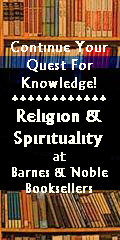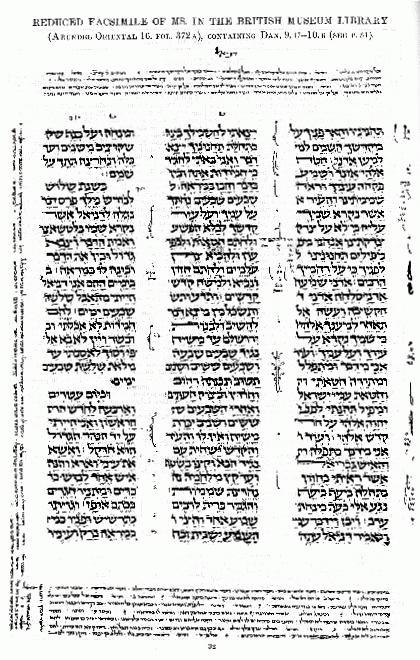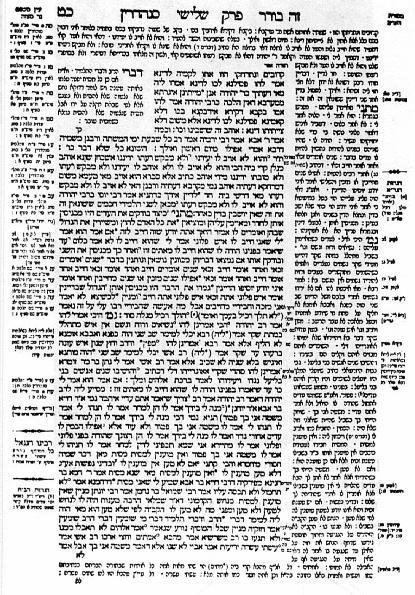
May You Be Blessed by the God of Your Heart |
Hebrew and the Texts of JudaismThe Hebrew Bible:Hebrew is a Semitic language, akin to such diverse languages as Arabic and
Maltese. It is written from right to left and so books are typically read
from what we would consider the back. The Hebrew language was originally written
without vowels. Eventually, "vowel points" where inserted into the text of
the scriptures to preserve their pronunciation by the Masoretes. The first
written Hebrew was in a script no longer in use, called Paleo-Hebrew.
Paleo-Hebrew appeared similar to Phoenician and other scripts then in use in
that region, and was occasionally revived for commemorative uses; it was used
on coins minted during the Bar Kochba rebellion against the Romans.
After the exile in Babylon, Jews began to use the Aramaic language, and adopted the Ashuris, or the square lettered alphabet that is used today. It is now the only script that is permitted in the writing of Torah scrolls and other sacred texts (Megillah 9a). Although most of the Jewish Bible is written in Hebrew, there are small section written in Aramaic (or sometimes called Chaldean).
The text pictured here is a leaf from a scroll of the book of Daniel. Daniel
is written mostly in Hebrew with some sections in Aramaic. The text of Daniel
is pictured in large letters arranged in columns. The writing surrounding
the text are notations called the Masorah. Handcopying manuscripts
was an arduous task which often resulted in errors. Strict laws govern how
a scribe (sofer) copies scripture, in order to produce a text that is
kosher. A group of Jewish scholars known as the Masoretes noted various
phenomena associated with the text and wrote these down as checks for scribes
to check their work. As a result of the meticulous system they developed,
the biblical text has been wonderously preserved. When the 2,000 year old
Isaiah scroll was discovered among the Dead Sea Scrolls, the ancient text
only differed from the modern text by one letter! This text type, which is
the text accepted as canon by Jews, is known as the Masoretic Text.
The first Hebrew Bible was printed in 1488.
The Torah containing the Taryag mitzvahs (613 commandments)
was given to Israel with a particular understanding of how the commandments
were to be kept. This understanding was the Mishnah, or the oral
torah; that is, it was passed orally from generation to generation.
Together, the Torah with the Mishnah and the rulings by the rabbis came to
be the codification of the law known as halakhah.
After the final Roman destruction of Jerusalem and the consequent ouster of the Jews from Jerusalem, great schools of learning gained prominence in Babylon. It was determined that to properly preserve the oral traditions from the uncertainties of the day it was necessary to put the Mishnah to paper. By 400 CE, the Mishnah and the corresponding Gemara (commentary on Mishnah) were compiled by Rabbi Judah the Prince to form the Talmud. This work is known today as the Talmud Bavli or Babylonian Talmud, a major work of many volumes. The lesser Jerusalem Talmud was compiled in Jerusalem. The primary language of the Talmud is Aramaic. The central body of the text contains both the Mishnah and the Gemara. That is surrounded by various commentaries made by important rabbis after the compilation of the Talmud. The column of small type on the left is a system of footnotes and cross references to other legal texts. The text to right of the Mishnah is the commentary of Rashi, an important rabbi from the eleventh century. The small type on the right is cross references to other places within the Talmud and notes on the text itself. Other commentaries are also found on other pages of the Talmud. Printed editions of the Torah are called the Chumash, meaning five. The Chumash will also contain similar features including a translation from the Hebrew to Aramaic called a targum. The most often used targum is by Onkelos, a Gentile convert to Judaism. Sources: The text from Daniel was obtained from The Bullinger Publications Trust, The Companion Bible. Grand Rapids, MI: Zondervan Bible Publishers, reprinted 1974, Appendixes, p. 32. The text of the Talmud was obtained from Strassfeld, Sharon and Michael Strassfeld, The Second Jewish Catalog. Philadelphia, PA: The Jewish Publication Society of America, 1976, p. 236. |

